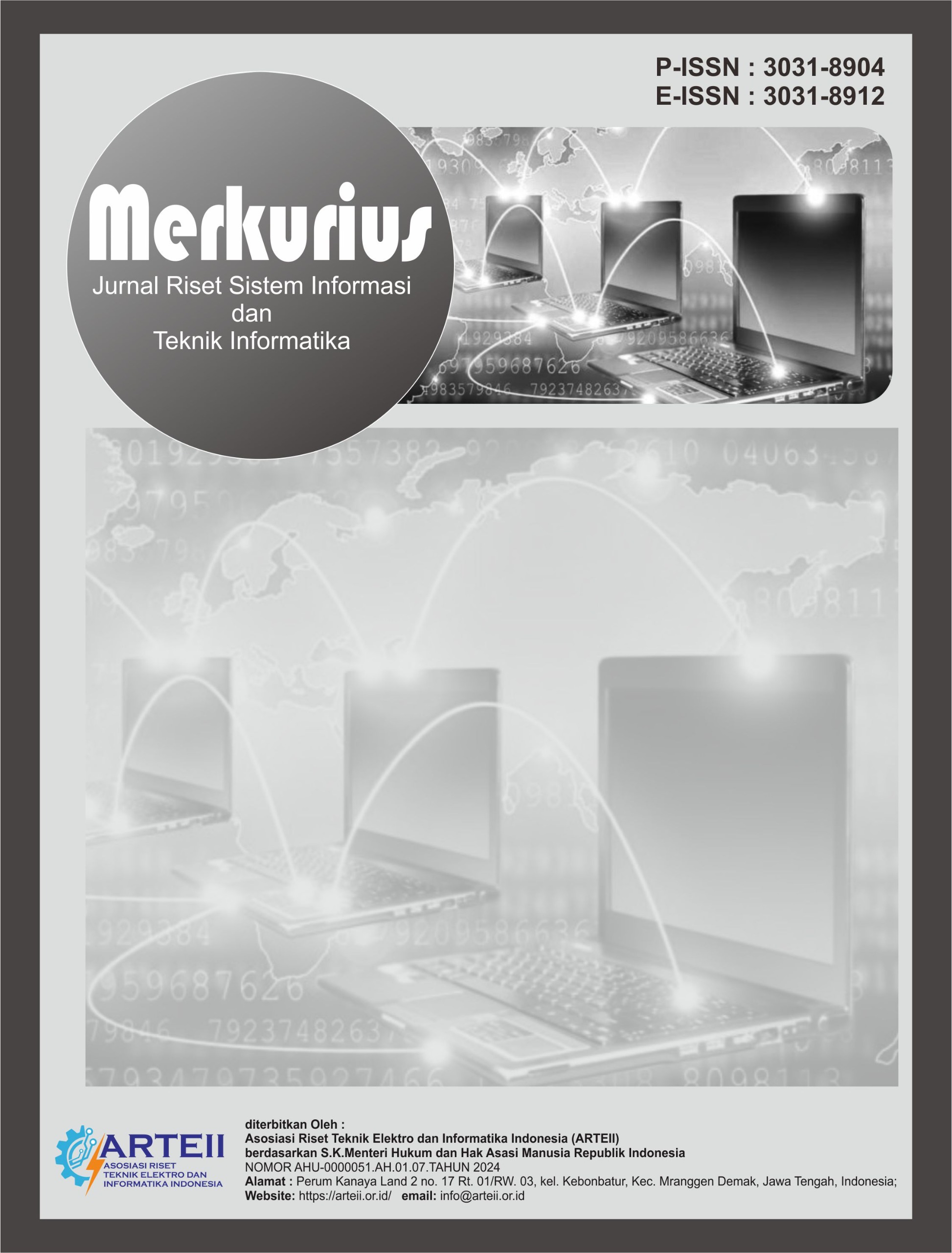Sistem Informasi Geografis Pemetaan Persebaran Perceraian Faktor Ekonomi dan Pertengkaran di Kota Surakarta Tahun 2020-2023
DOI:
https://doi.org/10.61132/merkurius.v3i1.598Keywords:
QGIS, Analysis, Spatial, DivorceAbstract
This study aims to utilize QGIS as a spatial analysis tool to map the distribution of divorces based on economic factors and disputes in Surakarta City during the 2020–2023 period. The data used includes spatial data in the form of Surakarta City's administrative map in shapefile format and non-spatial data comprising the number of divorces obtained from BPS Surakarta. Non-spatial data were integrated into spatial data using the "join attribute" feature in QGIS. The analysis process was conducted using classification methods to identify areas with the highest divorce density. The findings reveal that divorces due to economic factors are concentrated in low-income areas, such as Banjarsari and Jebres, while divorces caused by disputes exhibit a more evenly distributed pattern. The thematic maps were then exported into GeoJSON format for implementation on an interactive website accessible to the public and policymakers. This study contributes to the utilization of GIS technology in supporting data-driven decision-making.
References
Badan Pusat Statistik Surakarta. (2023). Jumlah perceraian menurut faktor dan kecamatan. Surakarta Kota. Retrieved from https://surakartakota.bps.go.id/id/statistics-table/2/MzYwIzI=/jumlah-perceraian-menurut-faktor-dan-kecamatan.html
Banerjee, S. (2020). Modeling massive spatial datasets using a conjugate Bayesian linear regression framework. Spatial Statistics, 37. https://doi.org/10.1016/j.spasta.2020.100417
Borpujari, C. (2020). Changing role of GIS technology in social science research and development: A geographical analysis.
Burt, D., Shen, Y., & Broderick, T. (2024). Consistent validation for predictive methods in spatial settings. ArXiv, abs/2402.03527. https://doi.org/10.48550/arXiv.2402.03527
Erlangga, E., Imanullah, I., Syahrial, S., Erniati, E., Imamshadiqin, I., Ritonga, G., & Siregar, D. (2022). Kondisi eksisting tiram (Bivalvia: Ostreidae) di perairan estuari Desa Banda Masen Kecamatan Banda Sakti Kota Lhokseumawe. Buletin Oseanografi Marina. https://doi.org/10.14710/buloma.v11i2.39514
Fauzan, A., Mujahid, I., & Maryandi, Y. (2022). Faktor-faktor peningkatan angka perceraian di Pengadilan Agama Kota Bandung (Periode 2019-2020). Jurnal Riset Hukum Keluarga Islam. https://doi.org/10.29313/jrhki.vi.1255
Franchi, F., Graziosi, F., Di Fina, E., & Galassi, A. (2024). A survey of cloud-enabled GIS solutions toward edge computing: Challenges and perspectives. IEEE Open Journal of the Communications Society, 5, 312–331. https://doi.org/10.1109/OJCOMS.2023.3344198
Gao, Y., Herrmann, A., & Chen, C. (2023). Leveraging GIS and ChatGPT for social goods and higher education. Proceedings of the ALISE Annual Conference. https://doi.org/10.21900/j.alise.2023.1392
Hashtarkhani, S., Tabatabaei-Jafari, H., Kiani, B., Furst, M., Salvador-Carulla, L., & Bagheri, N. (2021). Use of geographical information systems in multiple sclerosis research: A systematic scoping review. Multiple Sclerosis and Related Disorders, 51, 102909. https://doi.org/10.1016/j.msard.2021.102909
Martin, M., & Schuurman, N. (2020). Social media big data acquisition and analysis for qualitative GIScience: Challenges and opportunities. Annals of the American Association of Geographers, 110, 1335–1352. https://doi.org/10.1080/24694452.2019.1696664
Pavani, P., Komatireddy, S., Yarasuri, V., Police, V., Tanneru, S., & Habelalmateen, M. (2024). Spatial analysis for better marketing decisions with special focus on consumer behaviour patterns. E3S Web of Conferences. https://doi.org/10.1051/e3sconf/202452904007
Raju, P. (2021). Spatial data analysis. GIS. https://doi.org/10.5040/9781350129597.0012
Ricker, B., Rickles, P., Fagg, G., & Haklay, M. (2020). Tool, toolmaker, and scientist: Case study experiences using GIS in interdisciplinary research. Cartography and Geographic Information Science, 47, 350–366. https://doi.org/10.1080/15230406.2020.1748113
Rocheford, M. (2021). GIS for science: Applying mapping and spatial analytics. Photogrammetric Engineering & Remote Sensing. https://doi.org/10.14358/PERS.87.2.75
Skyba, V., Hanchuk, M., Vozniuk, N., & Likho, O. (2022). Interactive GIS-maps in teaching environmental science disciplines. Scientific Papers of Berdiansk State Pedagogical University Series Pedagogical Sciences. https://doi.org/10.31494/2412-9208-2022-1-2-408-422
Sulistiyaningsih, N., Hastuti, L., & Harahap, B. (2022). Pendampingan hukum perkawinan Islam dalam upaya mengurangi angka perceraian di masa pandemi. Jurnal Dedikasi Hukum. https://doi.org/10.22219/jdh.v2i3.23386
Szyszka, M., & Polko, P. (2020). Interactive maps of social problems and security threats illustrated with an example of solutions currently used in Upper Silesia. Sustainability. https://doi.org/10.3390/su12031229
Vitianingsih, A., Suryana, N., & Othman, Z. (2021). Spatial analysis model for traffic accident-prone roads classification: A proposed framework. IAES International Journal of Artificial Intelligence (IJ-AI). https://doi.org/10.11591/IJAI.V10.I2.PP365-373
Westerveld, L., & Knowles, A. (2020). Loosening the grid: Topology as the basis for a more inclusive GIS. International Journal of Geographical Information Science, 35, 2108–2127. https://doi.org/10.1080/13658816.2020.1856854
Downloads
Published
How to Cite
Issue
Section
License
Copyright (c) 2024 Merkurius : Jurnal Riset Sistem Informasi dan Teknik Informatika

This work is licensed under a Creative Commons Attribution-ShareAlike 4.0 International License.





